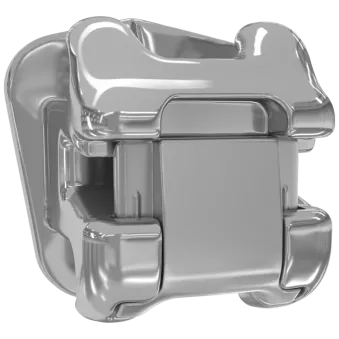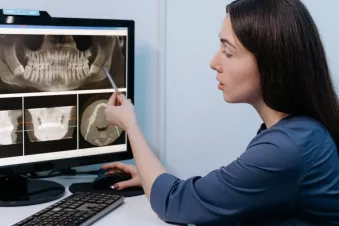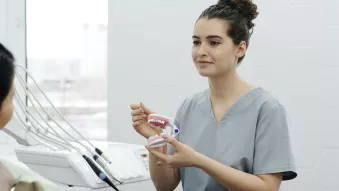
How braces straighten teeth
Today we have the pleasure of speaking with Dr. Sharleen Tan, who works with Braces in Orleans, an orthodontic office in Ontario, Canada. We had the pleasure of discussing orthodontic teeth movement, performance during COVID-10, and the advantages of the Damon Braces System, especially when it comes to moving teeth and patient experience.
Q: Thank you so much for taking the time to talk with us. Can you give us some information on your background in orthodontics and, if possible, tell us how many patients you have treated using braces?
A: Sure! I have been an orthodontist for 22 years now. I would estimate that I've had my hand in treating probably 8,000 patients as an associate and a practice-owner.
Q: Based on that experience, can you tell us about some of the more common malocclusions that you typically treat with braces?
A: Yes, I treat all types of malocclusions with braces: crowding, spacing, cross bites, overbites, and underbites. I use passive self-ligation braces for all of them. Other appliances or jaw surgery may be needed to treat some malocclusions, but my choice is to use a passive, self-ligation bracket, which is normally Damon™ or Insignia™ braces. In my practice, I have been able to use Damon Braces to treat any malocclusion that we identified during the detailed assessment.
Q: For our audience, a lot of times they are just getting started in their research for how braces work and why they work. Using the simplest terms, you can, can you please explain how braces actually work to move teeth?
A: Brackets are glued onto the teeth and they are used to hold an orthodontic wire in place. It is the wire that actually does most of the work to move the teeth. The wire and brace interaction cause the tooth to move. Wires exist in different sizes and materials. The wires exert light forces on the brace, and this is what makes the teeth move. That combination, together with rubber bands that connect from the top to the bottom teeth, allow your orthodontist to control how the teeth will bite together.
Q: Thank you for breaking that down so succinctly. In terms of teeth movement, do Damon Braces provide any advantages?
A: Damon Braces are what we refer to as passive self-ligating braces. This means that there's a door that slides on the brace that holds the wire in place, as opposed to a traditional brace, which does not have that door. With traditional braces, the wire is held in place by a tiny rubber band. We know that elastics lose their elasticity over time. Because of this, the wire does not work as efficiently after a period of time. With traditional braces, patients usually have to see the orthodontist for more frequent adjustments than they do with Damon Braces.
Q: Would you say, in general, that, with Damon Braces, patients can expect to spend less time at the doctor?
A: Yes, definitely. In my experience, the appointment time to adjust wires for patients in Damon Braces is much faster than for traditional braces. I have also found that treatment times in general are shorter for the patients who are in Damon Braces. With all other factors being equal (cooperation, oral hygiene, elastics wear etc.), I do enjoy and prefer the efficiency of the Damon Braces.
Q: One thing a prospective patient wants to know, is what is needed to non-surgically correct some of the more severe malocclusions?
A: There are cases where extractions and/or surgery are still needed regardless of the bracket system used. In my hands, I am very familiar with the ins and outs of the Damon System. The orthodontist still needs to treat within the biologic limits of each patient. Using passive self-ligation braces can turn a borderline extraction or surgical case into a non-extraction or non-surgical case. In these situations, we need excellent patient cooperation with oral hygiene and elastic wear, as well as light continuous forces on the teeth and bone.
Q: And are there any scenarios where you would recommend another appliance other than braces to treat the condition?
A: Almost all my treatments are done with braces. There may be other procedures needed like surgery or other appliances, but braces – and specifically Damon Braces – are what I prefer to get the final, desired results.
Q: Thank you so much for sharing such great information! Is there anything additional that you think patients should know when looking for the best braces product to fit their needs?
A: Because the passive self-ligation system can be more efficient than traditional braces, I find that the initial straightening of the teeth occurs so much faster. When elastics are worn at the beginning of treatment, the bite starts to come together alongside the alignment. This combination allows me to have the precise control of a case very early on, which, in turns, allows me to spend time doing the finishing touches on a case. We all know that applying the finishing touches to anything takes time. I love the feeling of seeing the finish line early in the treatment. When I was using traditional braces, I wouldn't always achieve the same milestones in the treatment progress as I can with Damon Braces. During the COVID-19 lockdown that took place for three months earlier this year, I found the Damon cases worked out really well. Even though they haven't been adjusted in three months or more because of the backlog, I’ve found my Damon cases made progress. They did not lose any time in their overall treatment time despite missing some in-office appointments due to government shutdown orders.


